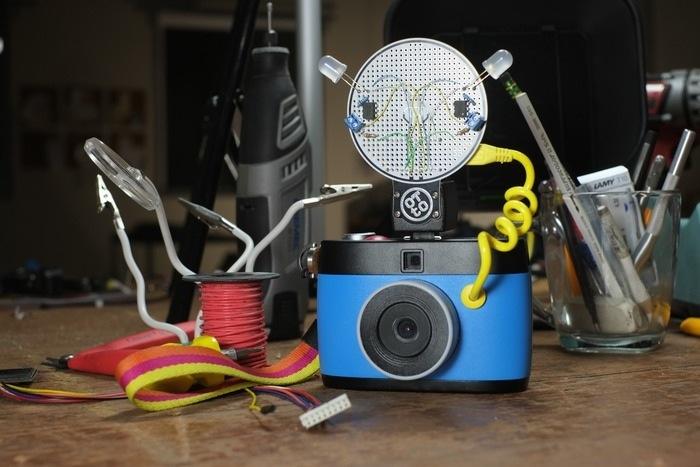
Ever wish you could hack your camera to do more than it can? While there are unofficial software hacks like CHDK and Magic Lantern that enable new shooting features, most of us are stuck with whatever camera companies give us. Which is what the guys behind the new Otto didn’t want to do. Currently seeking some funding on Kickstarter, the Otto is described as a customizable camera that can automatically generate animated GIFs, but it’s actually so much more than that. With some basic computer know-how, you can hack the Otto to become whatever camera you want it to be.
On the surface, the Otto resembles a big kids’ camera. If it looks like one of the toy cameras Lomography sells, that’s because Otto’s creators (Oakland, Calif.-based The Next Thing Co.) were inspired by old-school cameras; there’s even a crank on top that’s reminiscent of film cameras. The whimsical design is obviously more about fun. For example, that crank lets you easily shoot animated GIFs by simply rotating it to take the images (stop cranking to pause it, then resume cranking for the next shot, and so on), then rewind it once to finalize the GIF.

But don’t let the simple design belie its potential. Powering the camera is actually a mini computer, the Raspberry Pi Compute Module, a smaller version of the Raspberry Pi Model B; according to the company, the Otto is the first product to be powered by the module, and the small size allows the camera to stay compact. Because Raspberry Pi is a low-cost platform that can be customized, it means the Otto can be hacked to do different things – things that its creators probably didn’t even dream of. With support from the Raspberry Pi Foundation and a community of 2.5 million users, there’s plenty of potential.
That’s the future, of course, so let’s come back to what the Otto currently is. The module uses a Broadcom BCM2835 system-on-chip (SoC), which is a “700MHz ARM 11 core, with dual-core video co-processor and 1080/30p native H.264 hardware encode/decode, advanced Image Sensor Pipeline, 4GB of onboard flash memory, USB 2.0, and lots of other goodies,” the company says. The camera itself is the Raspberry Pi Camera Module (the Omnivision 5647) that connects to the SoC. On the top are the crank, shutter button, hot shoe, and a 96 x 96 OLED display. There’s also an optical viewfinder.

The camera uses is a 1/4-inch 5-megapixel back-illuminated sensor with an f/2.0 fixed glass lens. The camera can record videos Full HD at 1080/30p, and shoot images in RAW format. It’s not the strongest specs you’ll find in a camera; according to Raspberry Pi, image quality is equivalent to that of a smartphone, but even smartphone cameras are getting better. A USB port on the front (covered by the logo) makes the camera expandable via accessories, such as the Otto’s Arduino-based (another open-source, low-cost computing platform) FlashyFlash circuit board or perhaps a thumbdrive for extra storage (considering that 4GB of onboard storage isn’t a whole lot).
Of course, a camera like this isn’t completely about image quality, but the experience of taking fun photos. The camera doesn’t function on its own, and relies on a companion smartphone app. Through the app, you can set the shooting mode, sync the photos from camera to phone, and upload photos for sharing. Even though Otto theoretically can be hacked to do different things, the camera only works in one mode at a time, and you’ll need to pull out your smartphone every time you want to change the mode – a small inconvenience, but the point is to experience one mode at a time.
Here’s how the company describes it: “Modes are what makes Otto different from every other camera. Modes are like tiny apps that define how Otto makes pictures. In other words: modes change what happens when you press Otto’s shutter button or turn its built-in crank.
“Otto’s modes have tons of detailed settings that you can adjust from inside the smartphone app. Without any special skills, you can completely change how Otto’s modes react to your input. Once you’ve made your tweaks, your settings are automatically sync’d to Otto. Then you can put your phone away, go outside, and enjoy taking photos that are really yours!”

Besides the animated GIF mode, you can set the camera to add wacky effects on photos, shoot time-lapse images, or act as a photo booth. Otto comes pre-loaded with modes, but user-created modes can be added down the line, via the smartphone app. Because the camera can be programmed through the app, tweakers can instruct Otto to do things like automatically upload photos to the Web.
The creators of Otto say the camera’s intention is not to supplant the DSLR (with the listed specs, it won’t replace a compact camera or smartphone), but to be more fun. You could use it as a standard camera, but that’s beside the point. It’s all about experimenting, going back to the olden days of computers where you get to hack it to do what you want – in this case, for photography. You could technically build your own Otto camera by buying the components and connecting them together, but you’d be missing out on the unique case, software/smartphone app, and hardware expansion. The Otto would make a great gift for kids, as it could get them interested in both photography and computers.
The Kickstarter campaign ends on June 14, and the Otto is halfway to reaching its goal of $60,000 (as of May 21, 2014). If you want one, the minimum pledge is $199. Pledge $5,000, and the company will help you create a custom mode that’ll be included in the app.


